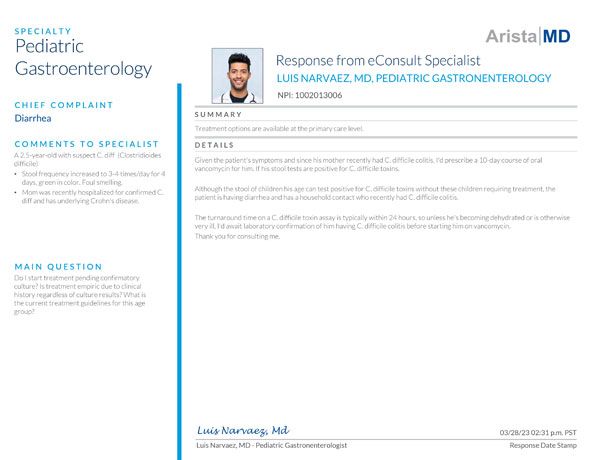Pediatric Gastroenterology
Diarrhea
SPECIALTY
Pediatric Gastroenterology
CHIEF COMPLAINT
Diarrhea
COMMENTS TO SPECIALIST
A 2.5-year-old with suspect C. diff
- Stool frequency increased to 3-4 times/day for 4 days, green in color. Foul smelling.
- Mom was recently hospitalized for confirmed C. diff and has underlying Crohn’s disease.
MAIN QUESTION
Do I start treatment pending confirmatory culture? Is treatment empiric due to clinical history regardless of culture results? What are the current treatment guidelines for this age group?
Request an eConsult Demo

What Providers Need to Succeed in Value-based Payment Models
How can primary care providers make this transition and seamlessly assume risk? Reimbursement for individual encounters, procedures, and services creates a burden for both the patient and the providers. In theory, the more you do, the more you are paid. In reality, taking a phone call, coordinating with a specialist, and researching medication alternatives are tasks that the fee-for-service payment model does not typically cover. Another unintended consequence of this payment model is a rise in siloed care – physicians do not have the time or the incentive to coordinate.
Low-lift Technology to Support Value-based Payment
Practices have struggled to implement and update expensive Health Information Technology (HIT) systems such as electronic health records (EHRs) and clinical decision support systems (CDSS). While these tools can help providers manage patient data, identify high-risk patients, and track quality metrics, the implementation timeline often requires a significant upfront investment and lengthens the transition to value-based care.
After emergency investment in high-cost, high-touch telehealth platforms, many practices are confused and frustrated by the number of solutions entering the market. A plethora of AI tools are launching — from Google’s new partnership to applications that record the provider-patient discussion to eliminate paperwork.
Will these tools solve the immediate problems that underlay the reason the healthcare industry is moving to value-based care, like the need for:
- Proper care coordination
- Better patient compliance
- Greater focus on prevention

